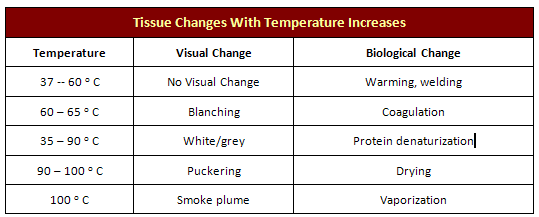Four specific interactions can occur when laser energy is delivered to the tissues;
- Reflection – occurs when the angle of reflection is equal to the angle of the oncoming light.
- Scattering – Occurs when the laser light energy within the tissue can be altered when the beam is scattered though the tissue.
- Transmission – Some laser wavelengths can be transmitted through certain tissues or solutions but have little or no thermal effect
- Absorption – Absorption of laser energy depends on the wavelength and fluence of the beam, tissue color, consistency, and water content.

There are three broad categories regarding tissue responses to the laser energy:
- Thermal
- Mechanical
- Chemical.
Most surgical lasers produce thermal effect at the tissue level. This includes the ability of the laser to cut, coagulate, vaporize, and ablate tissues. Some lasers mechanically disrupt tissues by producing sonic (acoustic) energy, like the breaking apart of kidney stones in the ureter. Activating light-sensitive medications to disrupt and change tissue is an example of the chemical effect a laser beam can produce.
The depth of penetration of the laser beam depends on the wavelength, color and consistency of the tissue, power intensity, exposure duration, and spot size.
